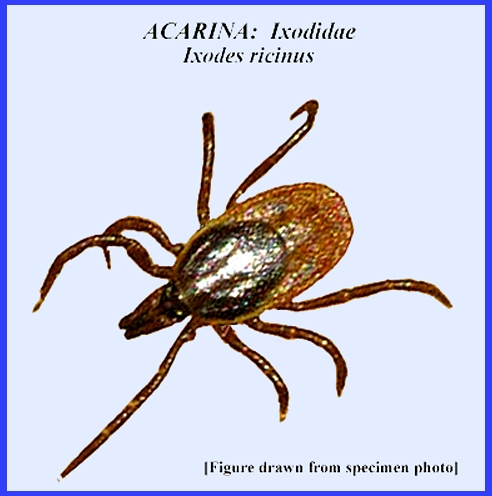File: <russiantickencephalitis.htm> <Medical
Index> <General Index> Site Description Glossary <Navigate
to Home>
|
RUSSIAN TICK ENCEPHALITIS (Contact) Please CLICK on
Image & underlined links for details:
The principal
vector east of Siberia is the tick Ixodes
persulcatus, and in Europe Ixodes ricinus (Service 2008). Other tick species that have been found to
be infected are Dermacentor silvarum,
Haemaphysalis concinna
and H. japonica, but human
transmission is not established. There are two peaks of infection: spring and
summer and ticks are active in a two or three-year cycle. Symptoms are
typically flu-like, and last variable lengths of time depending on the health
of the patient. The virus
multiplies in the tick, migrating to the salivary glands. Human infection occurs from a tick
bite. The ticks themselves, deer,
birds, small rodents and insectivores may be reservoirs for the virus. Service (2008) notes that there is
transstadial and transovarial transmission, but humans are not part of the
natural transmission cycle but only are accidentally infested with
ticks. The virus also resides in the
mammary glands of goats, sheep and cows, whereby humans risk infection by
consuming infected unpasteurized milk or cheese. Russian Tick
Encephalatis - Life Cycle = = = = = = = = = = = =
= = = = = = = = Key References: <medvet.ref.htm> <Hexapoda> Camicas, J. L., J. . Hervy, F. Adam & P. C.
Morel. 1998. The ticks of the world (Acarida,
Ixodida): Nomenclature, Described
Stages, Hosts,
Distribution. Paris: Editions
de l'ORSTOM.. Gammons, M. & G. Salam. 2002. Tick
removal. Amer. Fam. Physician
66: 643-45. Gothe, R., K. Kunze & H. Hoogstraal. 1979.
The mechanisms of pathogenicity in the tick paralyses. J. Med. Ent. 16: 357-69. Hoogstraal, H.
1966. Ticks in relation to
human diseases caused by viruses.
Ann. Rev. Ent. 11: 261-308. Hoogstraal, H.
1967. Ticks in relation to
human diseases caused by Rickettsia
species. Ann. Rev. Ent. 12: 377-420. Legner, E. F. 1995.
Biological control of Diptera of medical and veterinary
importance. J. Vector Ecology 20(1):
59_120. Legner, E. F. 2000.
Biological control of aquatic Diptera. p. 847_870.
Contributions to a Manual of Palaearctic Diptera, Vol.
1, Science Herald, Budapest. 978 p. Matheson, R. 1950.
Medical Entomology. Comstock
Publ. Co, Inc. 610 p. Needham, G. R. & P. D. Teel. 1991.
Off-host physiological ecology of ixodid ticks. Ann. Rev. Ent. 36: 313-52. Parola, P. & D. Raoult. 2001. Tick-borne
typhuses. IN: The Encyclopedia of arthropod-transmitted
Infections of Man and Domesticated Animals.
ed. M. W. Service, Wallingford: CABI:
pp. 516-24. Service, M.
2008. Medical Entomology For
Students. Cambridge Univ. Press. 289 p Sonenshine, D. E., R. S. Lane & W. L. Nicholson.
2002. Ticks (Ixodida). IN:
Medical & Veterinary Entomology, ed. G. Mullen & L.
Durden,
Ambsterdam Acad. Press.
pp 517-58. Sonenshine, D. E. & T. N. Mather (eds.) 1994.
Ecological Dynamics of Tick-Borne Zoonoses. Oxford Univ. Press, New York. Steer, A., J. Coburn & L. Glickstein. 2005.
Lyme borreliosis. IN: Tick-Borne Diseases of Humans, ed. J. L. Goodman, D. T. Dennis & D. E. Sonenshine. Washington, DC: ASM Press. |
